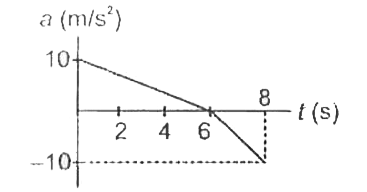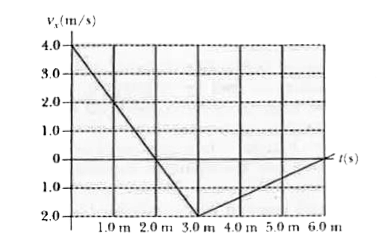The velocity of a particle moving with constant acceleration at an instant t0 is 10m/s After 5 seconds of that instant the velocity of the particle is 20m/s. The velocity at 3 second before t0 is:-
8m/s
4m/s
6m/s
7m/s
The correct Answer is:B
To solve the problem step by step, we will use the equations of motion under constant acceleration.
Step 1: Identify the known values
- Velocity at time t0 (initial velocity, u) = 10 m/s
- Velocity at t0+5 seconds (final velocity, v) = 20 m/s
- Time interval = 5 seconds
Step 2: Use the equation of motion to find acceleration
We can use the equation of motion:
v=u+at
Substituting the known values:
20=10+a⋅5
Now, solve for a:
20−10=5a10=5aa=105=2m/s2
Step 3: Find the velocity at t0−3 seconds
Now we need to find the velocity at t0−3 seconds. We will use the same equation of motion:
v=u+at
Here, u is still 10 m/s, a is 2 m/s², and the time t is -3 seconds (since we are looking back in time):
v=10+2⋅(−3)
Calculating this:
v=10−6=4m/s
Step 4: Conclusion
The velocity of the particle at 3 seconds before t0 is 4 m/s.
---
- Velocity at time t0 (initial velocity, u) = 10 m/s
- Velocity at t0+5 seconds (final velocity, v) = 20 m/s
- Time interval = 5 seconds
We can use the equation of motion:
v=u+at
Substituting the known values:
20=10+a⋅5
Now, solve for a:
20−10=5a10=5aa=105=2m/s2
Now we need to find the velocity at t0−3 seconds. We will use the same equation of motion:
v=u+at
Here, u is still 10 m/s, a is 2 m/s², and the time t is -3 seconds (since we are looking back in time):
v=10+2⋅(−3)
Calculating this:
v=10−6=4m/s
The velocity of the particle at 3 seconds before t0 is 4 m/s.
Topper's Solved these Questions
- BOOK - ALLENCHAPTER - MOTION IN A PALNEEXERCISE - EXERCISE-341videos
MOTION IN A PALNE
- BOOK - ALLENCHAPTER - MOTION IN A PALNEEXERCISE - SOLVED EXAMPLE28videos
MOTION IN A PALNE
- BOOK - ALLENCHAPTER - MOTION IN A PALNEEXERCISE - EXERCISE-199videos
MOTION IN A PALNE
- BOOK - ALLENCHAPTER - KINEMATICS-2DEXERCISE - Exercise (O-2)48videos
KINEMATICS-2D
- BOOK - ALLENCHAPTER - NEWTON'S LAWS OF MOTION & FRICTIONEXERCISE - EXERCISE (JA)4videos
NEWTON'S LAWS OF MOTION & FRICTION
Similar Questions
A particle is moving with a uniform accerleration. Its displacement at any instant t is given by s=10t+4.9t2. What is velocity at t=3 second.
View SolutionThe velocity of a particle moving in a straight line is decreasing at the rate of 3m/s per metre of displacement at an instant when the velocity is 10m/s. Determine the acceleration of the particle at this instant.
View Solution
Knowledge Check
- Question 1 - Select One
Average velocity of a particle moving in a straight line, with constant acceleration a and initial velocity u in first t seconds is.
Au+12atBu+atCu+at2Du2 - Question 2 - Select One
The velocity of a particle at an instant is 10m/s. After 5sec, the velocity of the particle is 20m/s. Find the velocity at 3 seconds before from the instant when velocity of a particle is 10m/s.
A8m/sB4m/sC6m/sD7m/s - Question 3 - Select One
The velocity of a particle at an instant is 10 m/s. After 5 s, the velocity of the particle is 20 m/s. The velocity at 3 s before the instant when the velocity of the particle was 10 m/s is
A8 m/sB6 m/sC4 m/sD7 m/s
A particle is moving under a constant acceleration of 3m/s2. The initial velocity of the particle is 10m/s. calculate the distance travelled by the particle is 5s and also in th 5th second of its motion.
View SolutionThe acceleration-time graph of a particle moving in a straight line is as shown in figure. The velocity of the particle at time t=0 is 2m/s. The velocity after 2 seconds will be
 View Solution
View SolutionA particle starts from rest with a time varying acceleration a=(2t−4). Here t is in second and a in m/s2
The velocity time graph of the particle isView SolutionThe acceleration - time graph for a particle moving along x - axis is shown in figure, If the initial velocity of particle is −5m/s, the velocity at t = 8 s is
 View Solution
View Solutionvx is the velocity of a particle moving along the x-axis as shown in the figure. If x=2.0m at t=1.0s, what is the position of the particle at t=6.0s ?
 View Solution
View Solution

